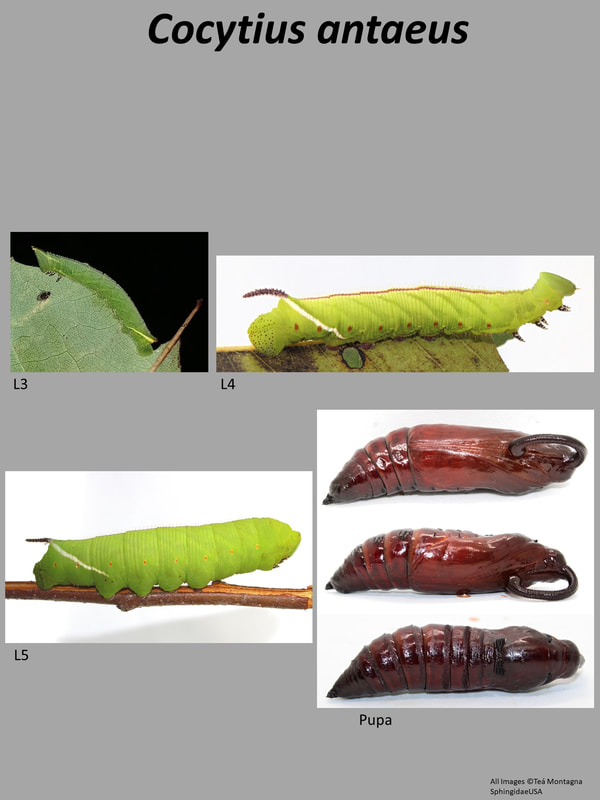|
Common Name(s): Giant Sphinx
Ecology and Life History: This moth is continually brooded in Florida, and as such larvae and adults can be present virtually year-round. In Southern California, it is active from February to November. I have recorded a flight of adults in late December to early January in South Florida, undoubtedly there are additional peaks. This moth is highly attracted to light, occasionally with numbers of individuals coming to lights. Bait would likely be ineffective for this species as it feeds on the nectar of orchids. This moth is not sexually dimorphic, females are slightly larger than males on average. Eggs are likely laid on the surface of a leaf rather than on the stems of plants. Younger larvae feed on the undersides and outer edge of the leaf. Larger instars hide under leaves during the day, and feed from the outer leaf edge until the leaf is consumed. Larvae thrash violently when disturbed, and given their size, it is quite a spectacle. Adults of this species are one of the few pollinators of Ghost Orchids, and have an impressively long proboscis. Habitat and Searching for Larvae: Larvae feed on Pond Apple (Annona glabra) in Florida, but other Annonaceae, such as Custard Apple (Annona reticulata) in California, may be suitable hosts as well. Larvae do not seem to feed high in the trees, though they are often over water. Final instar larvae are easy to find, as they create a distinctive feeding pattern. Larvae feed on a branch of Annona glabra from the terminal leaf inward, finishing each leaf before moving on. The larva hides underneath the uneaten leaves during the day (2). This is a moth of wet areas as that is where Pond Apple is most common. They can be found in swamps, flood plains, and other areas so long as sufficient hostplant is present. This moth is continually brooded in Florida and can be found year-round. I have recorded a peak of larval activity in mid-December in South Florida, undoubtedly there are many others. In California, there is a peak of activity between February and June, and again from September to November. This species glows incredibly well under UV flashlights. The lime-green coloration and bright white stripe makes finding this larva easy, even when located in the canopy of a tree. Rearing Notes: How to obtain eggs is unknown at this time. It is likely that placing a female in a paper bag or styrofoam cooler will give eggs, but they may need a flight cage. In South Florida, this moth seems to specialize on Annona glabra, but likely uses other Annonaceae elsewhere. In California, Annona reticulata is used. This moth is extremely susceptible to humidity, with larvae dying in a short time when the humidity is too high. Unfortunately, their hostplant likes to be humid when cut. As such, sleeving this moth on a potted plant or wild tree is a good way to rear them. If tupperware is used, they must be kept at a moderate humidity and have food changed daily. This species, due to its size is hard to rear in large quantity. Larvae do not like to be crowded, and too many larvae together will raise the humidity to a lethal amount quickly. Pupation can be achieved by placing the larva in loose soil, or by using the paper towel method outlined in the general information tab. If using the paper towel method, vent the container of excess humidity daily. Wild collected larvae are often victims of parasitoids, particularly Tachinidae. Host plants: Click here to load this Caspio Cloud Database
Cloud Database by Caspio |
Adult description:
As its common name implies, this is a very large moth with forewings varying from 65-92mm (2). The forewing appearance is similar to Manduca sexta, the difference being the size. The brown forewings are mottled with black, usually with a white discal spot and occasionally other whitish markings. The thorax of this moth is brown. The abdomen is brown with 3 pairs of bright yellow spots on the first three segments. The hindwings are quite distinctive. The basal area is yellow and next to it is a clear region. The bottom edge of the forewing is black. Larval description: L3: The larva is very rough with white speckling all over its body. The horn is pointed upward and purple in color. There is a large white streak that leads to the horn from the last abdominal segment. The head capsule is triangular and has two horn-like projections at the apex. The spiracles are dark in color, with a faint red spot in the middle. L5: The final instar larva is large, smooth, lime green and has a purplish horn. A distinctive white streak runs from the base of the horn through the last 3 abdominal segments of the larva. Restricted to South Florida. The spiracles are yellow with a bright red dot in the middle. The anal plate has significant black speckling. |
The gallery to the left contains photos of Cocytius antaeus adults. If you have a photo that you would like to submit to us, please contact us.
The gallery to the right contains photos of Cocytius antaeus larval and pupal stages. If you have a photo that you would like to submit to us, please contact us.
The gallery to the right contains photos of Cocytius antaeus larval and pupal stages. If you have a photo that you would like to submit to us, please contact us.






















